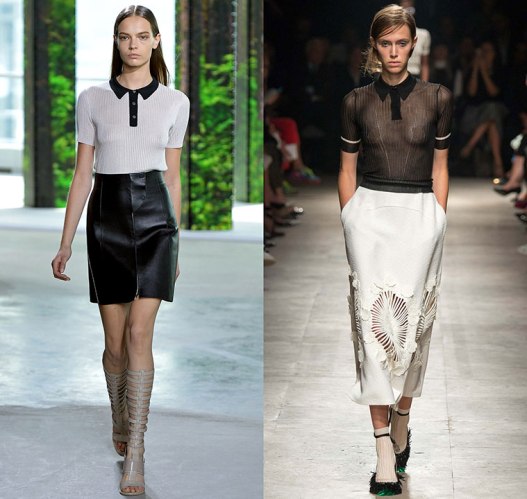Follow us over at TRENDBYNUMBERS.com.
Spring 2015 Runway
Spring Back, Fall Forward and the Mathematics of Fashion
This post marks the official end of HAPPENstijl on the Spring/Summer 2015 runways. Phew! I ended up whittling 200 some-odd runway matches down to the 88 examples presented on this site. I could have kept going, but the Pre-Fall 2015 runway collections are already trickling in, and, well, fashion waits for no one.
I’ve been doing this (trendhunting, runway analysis, etc.) for a long time now. I believe the 88 “instances of fashion coincidence” that I edited not only illustrate an interesting creative phenomenon but also the most viable new trends of the season. The keyword here is “new.” Of course you will always find similar-looking LBDs on the runway, but what pings my fine-tuned trendspotting radar is innovation in context, which could just mean a little slit up the side of a dress or a slash of python through the bodice. In the case of HAPPENstijl, observing at least two relevant designers executing this innovation in the same way strengthens mere instance into a trend. (What qualifies a designer as “relevant” is a subject to be tackled at a later date.) The one runway look that I strongly believed in yet could not find an adequate match for is the above image from Chloé. Seventies influences, salt ‘n’ pepper twill, a long-over-short silhouette? Absolutely perfect.
My work with Spring/Summer 2015 isn’t quite finished yet. The information-gathering portion is complete, but there is more analysis yet to be done. Which brings me to a new website I am working on: Trend by Numbers. HAPPENstijl will eventually be folded into TbN. Building on this blog’s premise of “two makes a trend,” the new site will pair the instinctive qualitative analysis I do here with data-driven representations and other metrics-based editorial products.
The biggest inspiration behind Trend by Numbers is sports analytics. I am an avid NBA and NFL fan. The only thing I enjoy more than the games is the post-game analysis. “Moneyball” and Nate Silver’s work are just small dents in sports’ sophisticated data science machine. I realize that performance metrics in sports are much easier to quantify than the visual, tactile language of fashion. What I am most driven by is how democratized the gathering and processing of data is in sports. The plethora of statistics each discipline keeps is widely available, as well as visual sources (video, photographs, illustrations) and modeling tools. Because of the accessibility of information, there is a huge culture of sharing (and learning) between laymen bloggers, professional statisticians and programmers alike, which only continues to advance innovation in the field. And also makes data a heck of a lot funner.
The Spring/Summer 2015 examples presented in the past two months here are a good place to start exploring “trends by numbers.” They provide a tightly edited sample size that I feel effectively reflect the season’s big concepts. The S/S 15 numbers are still being crunched into some cool data visualizations for the new site, but in the meantime, on with the Pre-Fall 2015 shows!









